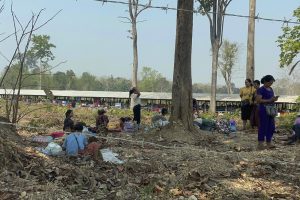Ethnic Karen rebels and their allies claim to have captured an important trade hub on the Thai border in southeastern Myanmar, despite a last-ditch effort by the Myanmar military to prevent the town’s fall.
In a statement today, the Karen National Union (KNU) announced that its armed wing, the Karen National Liberation Army (KNLA), and allied anti-junta People’s Defense Forces (PDFs) overran the headquarters of Infantry Battalion 275, the last junta outpost guarding the town. They took full control of the town of Myawaddy at around 4:20 a.m. this morning, the statement said.
“At this time, all military council [junta] camps in Myawaddy have been attacked and occupied. The remaining military council remains will continue to be cleared,” the statement said. “The public is advised to cooperate without panic.”
The statement, which confirmed earlier reports that the KNLA and its allies overran Infantry Battalion 275 last night, was accompanied by a photo showing a large cache of arms and ammunition captured from the battalion. Local media outlets also published the now-customary trophy shot of resistance fighters posed in front of the welcome sign to the town.
The capture of Myawaddy began with joint KNLA-PDF offensives late last year, but reached its decisive phase late last week, when these groups captured an important base at Thingannyinaung, 10 kilometers west of Myawaddy, which involved the surrender of 477 military personnel and 140 of their relatives. The KNU then began to negotiate the surrender of Infantry Battalion 275, which is based just outside of Myawaddy. When talks broke down, the KNLA and its allies launched an attack on the battalion’s headquarters on Tuesday afternoon.
This was followed by 36 hours of fierce fighting, which according to numerous reports could be heard yesterday from the Thai town of Mae Sot, which sits across the border from Myawaddy. Some reports also claimed that the junta was sending reinforcements from Hpa-an, the capital of Karen State, in order to relieve its forces around Myawaddy, the third-busiest land border crossing in Myanmar and the largest of its six crossings with Thailand. In comments given to Channel News Asia, KNU sources stated that the military regime had sent reinforcements, but that its forces had managed to defeat them.
The fighting has prompted Thailand to tighten security along the border. In a report yesterday, Reuters quoted several residents of Mae Sot as saying that “several Thai army vehicles, equipped with roof-mounted machine guns,” were patrolling the streets of the town, “even as the sound of explosions and heavy fighting rang out from across the border in Myawaddy.” Security measures have reportedly been increased further today, to prevent any Myanmar soldiers from attempting to flee across the Thai border.
While there were seemingly no clashes inside the town of Myawaddy itself, the violence has prompted many residents of Myawaddy to flee across the border. The Irrawaddy reported yesterday that 1,000 civilians from Myawaddy had walked across the 420-meter Thai-Myanmar Friendship Bridge to Mae Sot over the past two days, as the fighting neared the town. Earlier in the week, Thailand’s Foreign Minister Parnpree Bahiddha-Nukara said that the country was prepared to accept up to 100,000 refugees, should the fighting – and possible retaliatory aerial attacks by the junta – lead to large-scale displacement.
It is too soon to begin a full accounting of what the fall of such an important trade hub might mean for the trajectory of the conflict in southeastern Myanmar, let alone the country as a whole, but it is clearly a humiliating loss for the military administration that seized power in 2021. This is especially the case following significant recent losses in northern Shan State and Rakhine State. As Richard Horsey of the International Crisis Group told The Guardian this week, “What happens next in Myanmar isn’t simply a matter of the military’s battlefield losses – it’s also about the psychological impact such relentless defeats are having on the institution and the political ramifications in Naypyidaw.”
As for the KNU and its allies, the question now is, with the wet season fast approaching, whether they stop and consolidate their hold over the strategic border crossing and its attendant customs and border controls, or attempt to seize as much territory as possible to the west of Myawaddy before the monsoon sets in. Much depends also on how the military junta responds to this latest setback. In particular, the use of punitive aerial attacks, its recent preferred response to battlefield setbacks, could impede any further gains by the KNLA and lead to much larger displacements of civilians in eastern Karen State, even if diplomatic sensitivities prevent these from straying too close to the Thai border.
Looking forward, the KNU may well find itself facing a paradox: namely, if it is to benefit from sustained flows of trade through Myawaddy, this will require some sort of modus operandi to ensure that goods from KNU-held areas can be transported into those controlled by the military junta. Whether such “cooperation” might be the prelude to the hardening of a new status quo in Karen State, or merely represent a break in the conflict, remains to be seen.

































